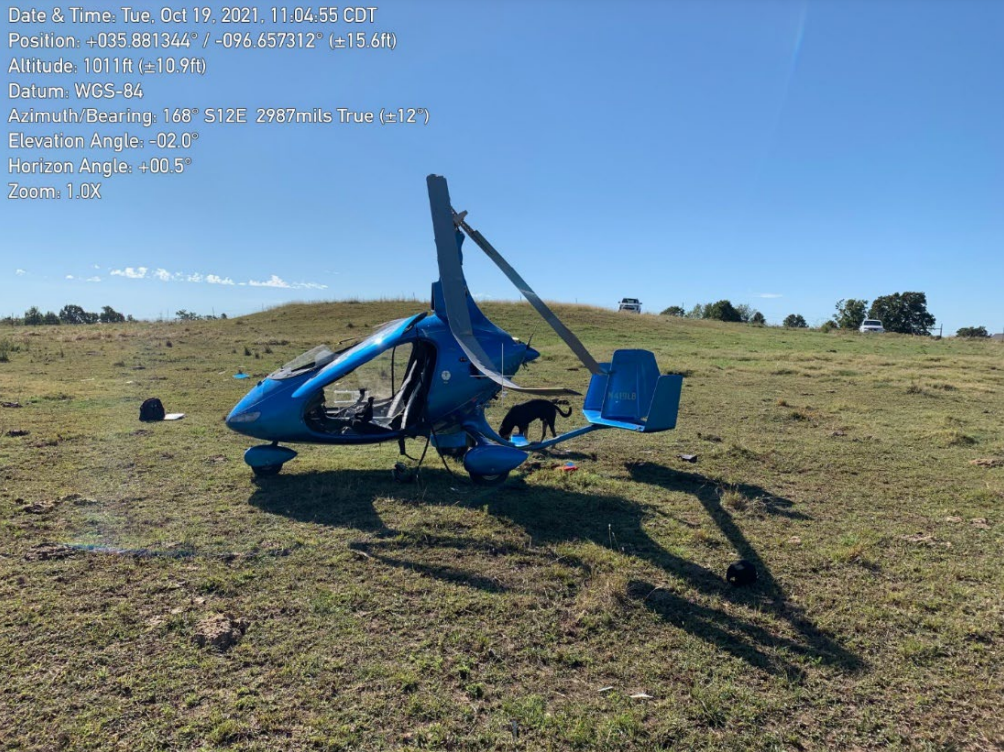
ASN Wikibase Occurrence # 269055
This information is added by users of ASN. Neither ASN nor the Flight Safety Foundation are responsible for the completeness or correctness of this information.
If you feel this information is incomplete or incorrect, you can submit corrected information.
| Date: | Monday 18 October 2021 |
| Time: | 15:34 |
| Type: |  AutoGyro Cavalon |
| Owner/operator: | SBS Program Office |
| Registration: | N419LB |
| MSN: | V00313 |
| Year of manufacture: | 2018 |
| Total airframe hrs: | 187 hours |
| Engine model: | Rotax 914 |
| Fatalities: | Fatalities: 1 / Occupants: 1 |
| Aircraft damage: | Substantial |
| Category: | Accident |
| Location: | Stroud, OK -
 United States of America United States of America
|
| Phase: | Take off |
| Nature: | Private |
| Departure airport: | Stroud, OK |
| Stroud, OK | |
| Investigating agency: | NTSB |
| Confidence Rating: |
On October 18, 2021, about 1534 central daylight time, an AutoGyro Cavalon gyroplane, N419LB, was substantially damaged when it was involved in an accident near Stroud, Oklahoma. The pilot was fatally injured. The gyroplane was operated as a Title 14 Code of Federal Regulations Part 91 personal flight.
A witness reported that the pilot purchased the gyroplane in January 2020 and has been undergoing flight lessons. Two days before the accident was the pilot’s first solo flight. On the day of the accident, the witness observed the gyroplane positioned heading to the north on a 300-yard, private, field. The wind was gusting from the south, which was a tailwind. The pilot added full engine power and the gyroplane started its takeoff roll toward the north. The gyroplane never lifted off the ground and impacted a barbed wire fence at the end of the field. The witness proceeded toward the accident site, and he observed that the pilot was ejected from the gyroplane. The gyroplane came to rest upright with the engine still running. After calling for help, he turned the engine off via cockpit controls.
The pilot’s flight instructor reported that the pilot had about 20 total hours of flight training over the course of about a year. He would fly a few hours at a time with large gaps in-between. The pilot traveled a long distance to obtain the instruction and about 3 months prior to the accident, he elected to move the gyroplane closer to his home despite the instructor informing him he was not ready for solo flight. It is unknown if the pilot obtained additional flight instruction as advised.
On scene examination of the airframe did not reveal any anomalies that would have precluded normal operations. A large hole was noted in the forward windscreen; the seatbelts remained secured to the airframe, and they were not clasped. Since the pilot was ejected, it is likely he was not wearing a seatbelt.
The nearest weather reporting station was about 7 nautical miles northwest of the accident site. At the time of the accident, wind was from 160° at 8 knots, gusting to 17 knots, which would have been a tailwind. The AutoGyro Cavalon Pilot Operating Handbook states under Environmental Limitations “Maximum tailwind component for take-off and landing…5 knots.”
The pilot’s toxicology results showed that he had used methamphetamine. His high methamphetamine blood level was consistent with methamphetamine abuse although the level does not indicate if he was experiencing early drug effects (possibly feeling alert, euphoric, and invulnerable, with a tendency to make high-risk decisions) or later effects (possibly feeling restless, disorganized, uncoordinated, and craving more drug). Toxicology results also showed that the pilot had used THC, although it is impossible to infer specific impairing effects from the measured levels of THC and its metabolites, or to predict how THC and methamphetamine effects may have interacted.
Given the pilot’s overall lack of experience, along with his decision to take off with a tailwind, it is likely he did not possess the necessary skill or experience to safely conduct solo flight. Therefore, it was impossible to determine whether impairment of his handling of the aircraft from drug effects contributed to the accident.
Probable Cause: The pilot’s lack of experience in the gyroplane and his decision to takeoff with a tailwind. As a result, the gyroplane did not generate enough lift to takeoff before it struck a barbed wire fence. Contributing to the accident was the pilot’s failure to wear a seatbelt, which would have reduced his level of injury.
Accident investigation:
 |
|
Sources:
NTSB
FAA
Location
Images:

Photo: NTSB
Media:
NTSB is investigating the Oct. 18, 2021, crash of a Cavalon Autogyro airplane near Stroud, Oklahoma.
— NTSB_Newsroom (@NTSB_Newsroom) October 19, 2021
Revision history:
| Date/time | Contributor | Updates |
|---|---|---|
| 19-Oct-2021 09:26 | Captain Adam | Added |
| 19-Oct-2021 14:30 | RobertMB | Updated [Time, Registration, Operator, Total fatalities, Total occupants, Other fatalities, Phase, Nature, Source, Embed code, Narrative] |
| 19-Oct-2021 14:43 | Captain Adam | Updated [Damage, Narrative] |
| 25-Oct-2021 14:51 | wilda | Updated [Country] |
| 25-Oct-2021 14:51 | harro | Updated [Registration, Country] |
| 15-Sep-2022 01:03 | Captain Adam | Updated [Time, Location, Departure airport, Destination airport, Source, Narrative, Category, Accident report, Photo] |
| 15-Sep-2022 01:04 | Captain Adam | Updated [Cn] |
Corrections or additions? ... Edit this accident description
The Aviation Safety Network is an exclusive service provided by:


 ©2024 Flight Safety Foundation
©2024 Flight Safety Foundation